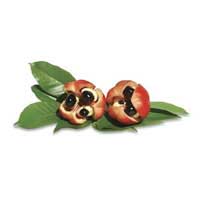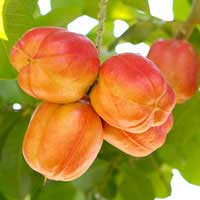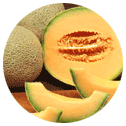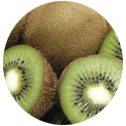 Full List of Fruits
Full List of Fruits  Ackee fruit
Ackee fruitAckee Fruit
Scientific name - Blighia sapida
Ackee, national fruit of Jamaica is a fruit that is yellow in color with black seeds. The edible fruit also known as aril is used in many cuisines. Treated like a vegetable in cooking its vivid red color on the outside, when ripped turns into yellow. The name Ackee is derived from the West African name "Akye Fufo", in general, the tree is a tropical evergreen tree that grows as tall as 40 feet. Rich in essential fatty acids, the fruit may be colored anywhere from straw to bright red. Allowing it to open and ripen naturally will be an added benefit. The fruit splits open while still on the tree to let slip 3 dead flat black seeds encircled by a thick, oily, yellow aril. They are also rich in vitamin A, zinc, and protein.
| Nutrient | Quantity | Nutritional Value |
|---|---|---|
| Fat | 18.78g | Supplies energy. Helps to prevent hypothermia |
| Protein | 8.75g | Builds and repair body tissue. Blood health |
| Water | 57.6g | For rehydration purposes. |
| Carbohydrates | 9.55g | For energy and the building of muscles. |
| Fiber | 3.45g | For colon health. To help lower blood glucose and cholesterol. |
| Calcium | 83mg | For bone and teeth health. |
| Iron | 5.2mg | For blood health. |
| Folates | 14 | 3.5% |
| Thiamine (Vitamin B1) | 0.10mg | For cardiovascular and the nervous system health. |
| Niacin (of the B complex vitamins) | 3.24mg | Health of the digestive system, skin, and nerves. |
| Riboflavin(B2) | 0.18mg | Red blood cell production and aids in metabolism |
| Ascorbic Acid(Vitamin C) | 65mg |
Colds.
Fever.
Water retention (edema).
Epilepsy.
Despite that, Ackee is a fruit; they are cooked and consumed as a vegetable and the method of using it while cooking varies significantly. It should be boiled vigorously when cooked such that the toxins are percolated into the water. The water must be discarded carefully. There's no fault in boiling it twice, but make sure that you use salt water when you are boiling the fruit for the second time. By this means, you can make sure that the fruit is toxin-free and then you can use them for making your desired recipes.
Even after boiling, there are chances for the seeds, pods, rind and membranes to contain toxin, so remove them and discard in a place that's out of reach for your pets and children.
The Ackee fruit is native to West Africa and is considered to be the national fruit of Jamaica.It is also known as the achee, akee, akee apple, and akee berry and is believed to have originated from the West African countries of Ghana and the Ivory Coast. Its scientific name is Blighia sapida and it is a member of the Sapindaceae family, which includes other fruits such as lychee, rambutan, and longan.
The Ackee tree is a medium-sized evergreen tree that can reach heights of up to 30 feet tall and is usually found near the sea. Its leaves are oval in shape, shiny, and dark green in color. The fruit of the Ackee tree is a bright red, yellow, or orange berry with a soft, creamy flesh.The Ackee fruit is a popular food in Jamaica and other parts of the Caribbean. It is usually eaten boiled, fried, or in salads and is often served with fish, rice, and beans.The fruit can also be used in jams and jellies, or added to desserts. Ackee is also used to make a popular Jamaican dish called Ackee and Saltfish.
The Ackee tree was first introduced to Jamaica in 1778 by Captain William Bligh, who had been shipwrecked on the island.He planted some of the fruit's seeds around his estate, which eventually spread throughout the island. The Ackee fruit is an excellent source of vitamins and minerals, including vitamins A and C, iron, calcium, and phosphorus. In addition, the Ackee fruit contains high levels of potassium, which helps maintain healthy blood pressure levels.The Ackee fruit is an important part of the Jamaican diet and culture. It is widely used in traditional dishes and is often served with fish, rice, and beans.Ackee is a popular food in Jamaica as well as in other parts of the Caribbean and the United States.
Ackee fruit is an excellent source of essential vitamins and minerals, providing high amounts of vitamins A, B1, B2, B3, and C. It is also a good source of iron, calcium, magnesium, phosphorus, and potassium. It is known to be beneficial for digestion due to its high fiber content. It can help to relieve constipation and reduce the risk of colon cancer.It contains high levels of monounsaturated fats and antioxidants, which can help to reduce the risk of heart disease.It is high in vitamin C, which helps to boost the body's natural immunity against diseases. Ackee fruit contains high levels of vitamin A, which can help to improve skin health and reduce the signs of aging. It can also help to protect skin from damage from the sun's UV rays. Ackee fruit is low in calories and can help to promote weight loss when consumed as part of a balanced diet.
1. Jamaican Ackee: This variety of ackee is the most popular and is native to Jamaica. It is a yellow-green color and is oval in shape. The fruit is usually between 3-5 inches in length and has a soft, buttery texture. It has a sweet flavor and is best enjoyed when cooked.
2. Haitian Ackee: This variety of ackee is native to Haiti. It is a darker green in color and has a rounder shape than the Jamaican variety. It is usually between 2-3 inches in length and has a firmer texture. The flavor is more tart than the Jamaican variety and is usually enjoyed when cooked.
3. West Indian Ackee: This variety of ackee is native to the Caribbean. It is a yellow-green color and is pear shaped. It is usually between 2-4 inches in length and has a hard texture. The flavor is sweet and nutty and is best enjoyed when cooked.
4. African Ackee: This variety of ackee is native to Africa. It is a yellow-green color and is round in shape. It is usually between 2-4 inches in length and has a soft texture. The flavor is sweet and is best enjoyed when cooked.


















